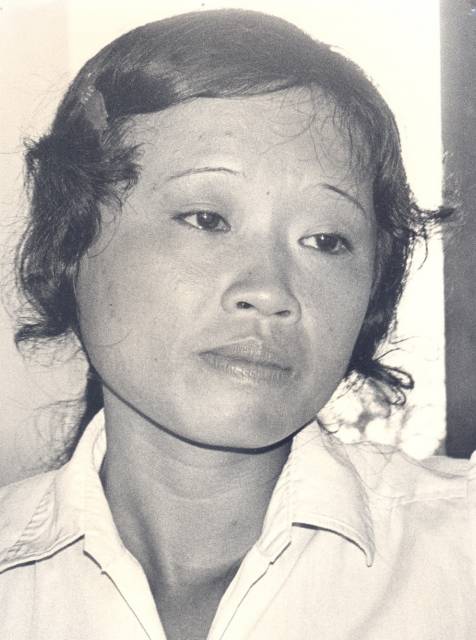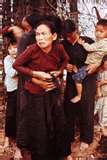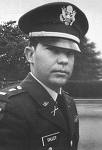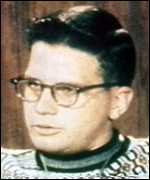|
I DIED TOO,
THAT MORNING IN MY LAI

Pham Thi Trinh - at the age of 10 she was one of a handful of survivors from the infamous My Lai massacre. 504 unarmed villagers were killed in March 1968.
It was a heart breaking encounter with Pham Thi Trinh - one of the few survivors of the My Lai Massacre, which killed 504 people on 16 March 1968.
We met her in the same village 17 years later.
Trinh broke down completely, when she took us to the spot, where she at the age of 10 had taken cover under the shattered body of her mother. Still, we persuaded her to go through all the details with us to get a complete picture of what happened during Operation Pinkville.
"We were having breakfast, when we heard the helicopters. We hid in the house, but the Americans pulled us out and lined us op. My mother took my little brother on the arm and put me behind her. The soldiers yelled at us: "You VC, VC." (Viet Cong, South Vietnamese/American slang for the guerillas, ed. note). They kicked and beat people with their riffle butts."
|
MURDER BY
THE NAME
OF WAR
A war crime exposed
"Seymor Hershhas not merely made a  meticulous reconstruction of a single massacre, but a powerful account of the madness unleashed by U.S. intervention in Vietnam. " meticulous reconstruction of a single massacre, but a powerful account of the madness unleashed by U.S. intervention in Vietnam. "
Editor Scott Shermann, Columbia Journalism Review
Private Ronald L. Haeberle's testimony at the Court Martial:
 "Guys were about to shoot these people. I yelled, 'hold it', and shot my picture. As I walked away, I heard M16s open up. From the corner of my eye I saw bodies falling, but I didn't turn to look." "Guys were about to shoot these people. I yelled, 'hold it', and shot my picture. As I walked away, I heard M16s open up. From the corner of my eye I saw bodies falling, but I didn't turn to look."
Private Robert Maple's testimony at the Court Martial:
 "We were grabbing up people. We went into hooches, got some of the people there and shot at them. Women and children, mostly. We just moved through the village. Calley and Meadlo were firing at the people. " "We were grabbing up people. We went into hooches, got some of the people there and shot at them. Women and children, mostly. We just moved through the village. Calley and Meadlo were firing at the people. "
|
Lt. William Calley's testimony at the Court Martial:
"There was about six to eight individuals laying on the floor, apparently dead. And one man was going for the window. I shot him. There was another man standing in a fireplace. He looked like he had just come out of the fireplace, or out of the chimney. And I shot him, sir. He was in a bright green uniform."

The commanding officer of Bravo company, Lt. William Calley was given a 10 year jail sentence at the military court but pardoned after serving five months. He went on to work in a jeweler store in Georgia, owned by his father in-law. |
Private Ronald L. Maedlo's testimony at the Court Martial:
 "I was ordered to. And I was emotionally upset ... And we were ordered to get satisfaction from this village for all the men we'd lost. They was all VC and VC sympathizers and I still believe they was all Viet Cong and Viet Cong sympathizers." "I was ordered to. And I was emotionally upset ... And we were ordered to get satisfaction from this village for all the men we'd lost. They was all VC and VC sympathizers and I still believe they was all Viet Cong and Viet Cong sympathizers."
 Pilot Hugh Thompson put an end to massacre, when he threatened to open fire with his maschine guns at Lt. Calley and the marines at the ditch. Thompson then brought a few survivors from the ditch on his helicopter for medical treatment at a nearby army base. Pilot Hugh Thompson put an end to massacre, when he threatened to open fire with his maschine guns at Lt. Calley and the marines at the ditch. Thompson then brought a few survivors from the ditch on his helicopter for medical treatment at a nearby army base.
|
"My mother fell on top of me"
"Then they started shooting. My mother fell down on top of me, still clutching my brother. His head had been shot off. My mother moaned in pain, and then one of the
soldiers put a gun to her head and killed her. I lay still, and they thought I was dead. I stayed under my mother's body, while the soldiers continued to shoot everybody in our village."
"The soldiers put everything on fire. After a while it became quiet, but many hours passed by, before I dared to crawl out from under my mother's body. I wandered around in our village, but I saw only dead people. Later I found out that a few others had also survived by hiding among the dead."
Trinh took us for a walk around the village and showed us, where she found the body of her aunt, the other kids she used to play with - and finally the roadside ditch where most of the villagers had been herded together and mowed down with M-16 rifles.
Pham Thi Trinh spoke for about an hour about her ordeal. Then summed up her life in a single sentence, with tears streaming down her face: "Somehow I died too, that morning."
Pham Thi Trinh bowed her head and left us with a quiet Chuc hai Anh mot ngay vui ve - I wish You a happy day. That morning this customary Vietnamese greeting seemed completely out of place.
A total of 504 people were killed in My Lai. The youngest victim was 1 year old, the oldest victim a 84 old year woman. There was one American casualty during the operation, a soldier who accidently shot himself in the leg.
Colin Powell: My Lai never happened
After the massacre several US soldiers wrote letters to the their superiors to alert the army to what had taken place. A major by the name of Colin Powell, who many years later became the US Secretary of State, was put in charge of an internal investigation. In his report he dismissed the allegations: "In direct refutation of this portrayal is the fact that relations between American soldiers and the Vietnamese people are excellent."
The massacre became undeniable one year later, when a US military photographer Ronald L. Haeberle passed on his private photos to an investigative journalist
Seymour Hersh.
Haeberle had used two cameras: The official army camera that only recorded interrogations and burning huts - and then his own camera, which documented the brutal slaying of the villagers - "murder in the name of war", as the massacre was later labelled in a BBC report.
Hersh met with immense difficulties - first in researching his way through the army cover-up and then being refused by editors, who did not believe his story. In desperation Hersh asked his neighbour, the editor of a small left wing New York news service to put it on the wire. The story was picked up by a few minor newspapers and let to a firestorm in the media. Hersh was later awarded the Pulitzer prize for his tenacity and became a star reporter of the New York Times. His book "My Lai 4" (Hersh got his title from the US military map) has become a classic of critical American reporting.
Only a junior officer, Lt. William Calley was court martialled and convicted for the murder of 22 civilians in My Lai. No one else were convicted for their part in the atrocities in My Lai. The military court in Fort Benning ruled that the soldiers involved had reason to believe that they were carrying out orders to eliminate active Viet Cong guerrillas.
Two years after our encounter with Pham Thi Trinh, I sat in with a group of former US Marines during their treatment in a therapy center in Anaheim, California. They had participated in similar 'cleaning operations of communist strongholds'. By recounting their own nightmares they confirmed the atrocities that had been denied consistently by the US army. Click here to meet US marine Bob Pope, who could not put the war behind him.
|